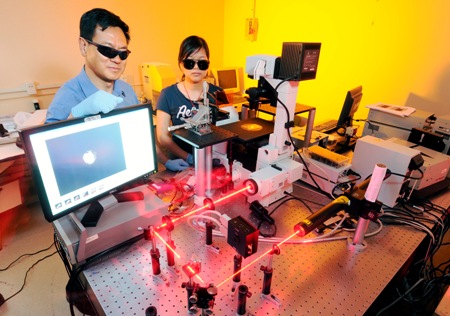The Georgia Institute of Technology researchers have utilized piezoelectric materials such as zinc oxide micro/nanowires to radically enhance the external efficiency of gallium nitride LEDs to produce ultraviolet light from electricity.
The research team improved the performance of its optoelectronic devices by generating a piezoelectric potential in the piezoelectric material through the application of mechanical strains onto it. The piezoelectric potential known as piezo-phototronics is used to improve carrier injection and modify the transportation of charges at the p-n junction in the LEDs.
 Georgia Tech Regents professor Zhong Lin Wang (left) and graduate research assistant Ying Liu study light-emitting diodes whose performance has been enhanced through the piezo-phototronic effect.
Georgia Tech Regents professor Zhong Lin Wang (left) and graduate research assistant Ying Liu study light-emitting diodes whose performance has been enhanced through the piezo-phototronic effect.
The researchers have used the piezo-phototronic effect to improve the recombination rate of holes and electrons to produce photons, which in turn improves the LEDs’ external efficiency by means of superior injection current and enhanced light emission. The gallium nitride thin film forms the ‘p’ part of a p-n junction, while the zinc oxide nanowires forms the ‘n’ part. At this junction point, free carriers were entrapped in a stream generated by the piezoelectric charge produced as a result of applying mechanical strain on the wires.
The research team manufactured its single zinc oxide micro/nanowire LED by using a wire over a trenched substrate. The team developed a magnesium-doped gallium nitride film epitaxially over a substrate using metalorganic chemical vapor deposition, and then used the film along with the zinc oxide nanowire to create a p-n junction.
The research team placed the cathode material, a sapphire substrate, alongside the gallium nitride substrate with an accurate gap, where the zinc oxide nanowire was placed with close proximity with the gallium nitride. The nanowire was covered with a transparent polystyrene tape. An alumina rod linked to a piezo nanopositioning stage is used to apply the force on the tape, which in turn compressed the wires.
The team then investigated the light emission changes by altering the strain values on 20 various devices. The devices formed with the reverse orientation of the nanowires demonstrated a decrease in efficiency, while the other showed improved efficiency. This variation was because of the reversal in the piezo potential sign due to the shift of the orientation of the nanowires from +c to –c.
The LEDs produced by the Georgia Tech research team generated emissions at ultraviolet wavelengths of 390 nm. However, Zhong Lin Wang, who serves as a Regents professor at the Georgia Tech School of Materials Science and Engineering, hopes that the wavelengths can be increased into the visible light region for an array of LEDs. He also believes that the innovative method developed by the research team can be used with other electrically controlled optical devices.